I’ve talked about finding a natural stopping point and conclusion multiple times on this blog and in class, and I’ve been thinking about it a lot as the course comes to a close. I’ve spent an inordinate amount of my life, and especially this semester, in rehearsals for various instrumental ensembles. Rehearsals are an opportunity to develop and refine the music; moments of perfection can be found in rehearsal if only due to pure repetition. Concerts, however, have little room for perfection, because of energy, nerves, human error, and countless other reasons. This is a kind of imperfection I’ve pretty much learned to live with, if only because there’s still half a program left to play or a completely new program to be performed in a couple weeks.
I think it’s partly because of my acceptance of this imperfection that I’ve allowed my perfectionism to run rampant with this project; WordPress’s seemingly endless customization possibilities have also helped. All of these options make it even more difficult to determine when any aspect of the site is finished, as “completed” or “polished.” Currently most of those decisions are about minor details including image placement, font size, and menu order, but sometimes I look at the site and wonder if the larger design features, like the theme, are actually the best out there, and if there’s not better plugins or images than what we’re using. My hesitance to declare the site “complete” extends to the research side of the project, though I’ve resigned myself to what’s on the site already do to the time constraint. There are relevant sources and topics I was barely able to touch on in the site due to lack of time, and conducting interviews about the public liberal has never seemed more important.
To return (sort of) to my original topic, most music has clear and natural endings marked by double barlines that are frequently telegraphed tens of measures in advance by the harmonic structure. Right now, this project has its own double barline approaching in the form of our presentation on Thursday, and I can already hear the crescendo of the V-I cadence. While I have no doubt that the site will be satisfactorily completed by the presentation, there’s a chance I’ll be changing minute, barely visible details until 1:59 on Thursday.
That being said, I’m astonished at how the site has turned out–I never really thought it could be so coherent and professional. This course has taken me farther out of my comfort zone than anything in my academic career, and I’m incredibly grateful. While the significance of the work this course is doing increases daily, and I hope more students have the opportunity to participate, I need an intermission.
Thanks to anyone who has been following this blog (and actually made it through this post).
![]()

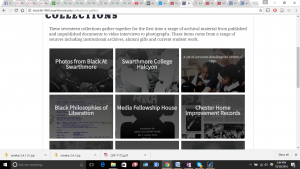 –this was the guiding website.
–this was the guiding website.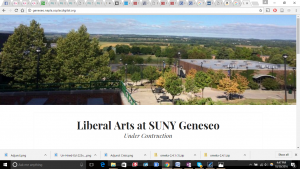
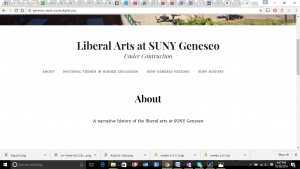 –here’s where we started.
–here’s where we started.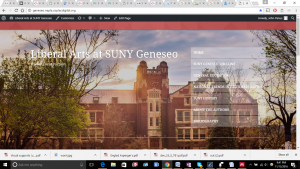 –after testing some themes, this is what I got. I think the picture of Geneseo works extraordinarily with this theme, but we’ll have to do some editing with the font, colors, and menu.
–after testing some themes, this is what I got. I think the picture of Geneseo works extraordinarily with this theme, but we’ll have to do some editing with the font, colors, and menu.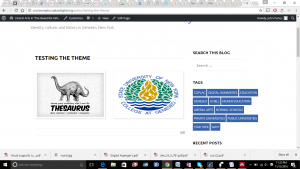 –here’s a template of how I thought the theme would work.
–here’s a template of how I thought the theme would work.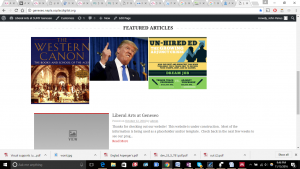 –that didn’t happen. When you add pictures to the home page, the site works differently. Obvious issues.
–that didn’t happen. When you add pictures to the home page, the site works differently. Obvious issues.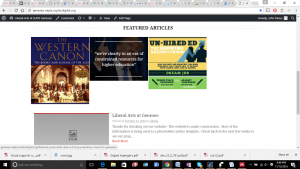 –the hover aspect is nice. But this theme does it automatically–whereas I spent hours working with plugins to get this affect on the other theme.
–the hover aspect is nice. But this theme does it automatically–whereas I spent hours working with plugins to get this affect on the other theme.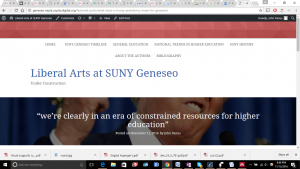 –and when you click on the site, it takes you to this page (which will later be filled with information). I had to do some editing to get here, and didn’t take all the picture to prove it.
–and when you click on the site, it takes you to this page (which will later be filled with information). I had to do some editing to get here, and didn’t take all the picture to prove it.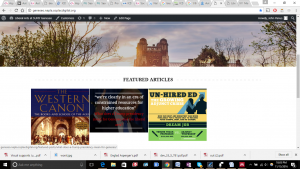 –this small change from the original hover effect is the change I’m most impressed with. I had to do some SERIOUS coding:
–this small change from the original hover effect is the change I’m most impressed with. I had to do some SERIOUS coding: –changing font size and color. Putting in a line break so there’s a primary title (the quote) and a secondary title (the question).
–changing font size and color. Putting in a line break so there’s a primary title (the quote) and a secondary title (the question).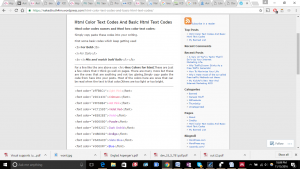 –and I seriously appreciate the people who paved the way before me.
–and I seriously appreciate the people who paved the way before me.